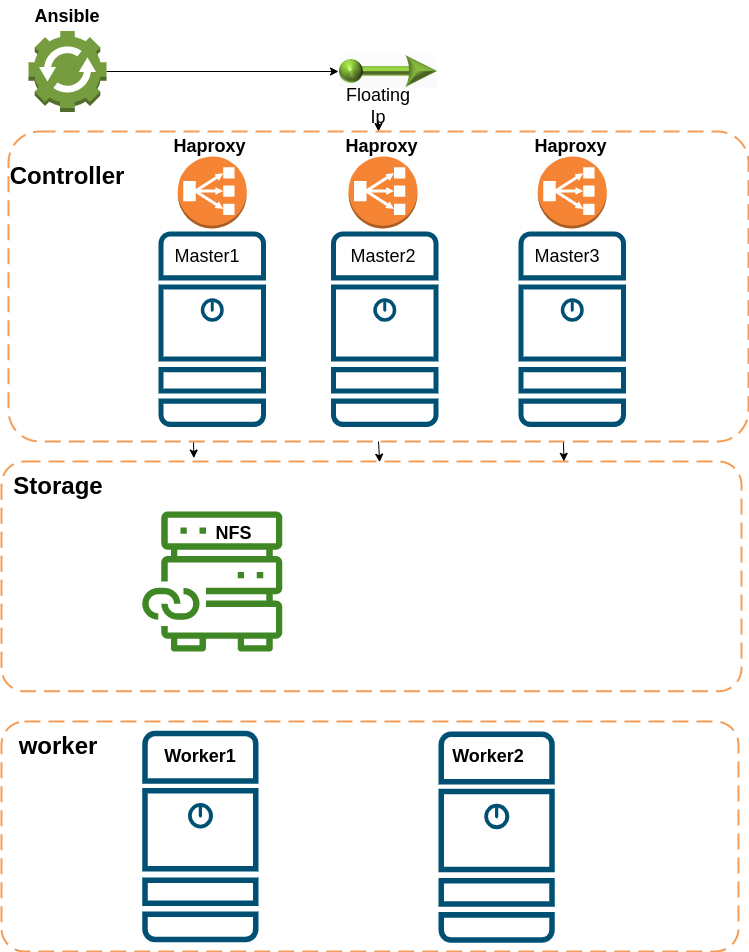This project helps you to deploy Kubernetes on Linux without a load balancer on cloud platforms.
- OS: Ubuntu (20.04)
- CPU: 2 core (per server)
- Ram: 2 GB (per server)
- Storage 25G (per server)
Follow the steps below to use this deployment project: Install Ansible on your client or deployment machine:
sudo apt update
sudo apt install software-properties-common
sudo add-apt-repository --yes --update ppa:ansible/ansible
sudo apt install ansible- Note: Copy the SSH key to your servers (master, worker, and storage):
# Generate SSH key
ssh-keygen
# Copy SSH key to servers
ssh-copy-id mater1 or your serverip
ssh-copy-id mater2 or your serverip
ssh-copy-id mater3 or your serverip
ssh-copy-id woker1 or your serverip
ssh-copy-id woker2 or your serverip
ssh-copy-id storage or your serverip
ssh-copy-id ha1 or your serverip
ssh-copy-id ha2 or your serverip
ssh-copy-id ha3 or your serverip- Note: Replace your_server_ip with the actual IP address of each server.
- Change the hostname on your servers:
ssh master1 hostnamectl set-hostname master1
ssh master2 hostnamectl set-hostname master2
ssh master3 hostnamectl set-hostname master3
ssh worker1 hostnamectl set-hostname worker1
ssh worker2 hostnamectl set-hostname worker2
ssh storage hostnamectl set-hostname storage
ssh ha1 hostnamectl set-hostname ha1
ssh ha2 hostnamectl set-hostname ha2
ssh ha3 hostnamectl set-hostname ha3
- Note: Before deploying Kubernetes with Ansible, update the variables in the default/main.yml file according to your infrastructure:
vim deault/main.yml
keepalive_ip : "172.16.16.200"
interface_name: "eth0"
pod_network_cidr: "192.168.0.0/16"
master1: "172.16.16.88"
master2: "172.16.16.104"
master3: "172.16.16.184"
storage_export: "172.16.104.0/24"
- Note: Modify the inventory file to match your infrastructure:
vim inventroy
[preinstall]
172.16.16.88 ansible_user=root
172.16.16.104 ansible_user=root
172.16.16.184 ansible_user=root
172.16.16.111 ansible_user=root
172.16.16.80 ansible_user=root
[master]
172.16.16.88 ansible_user=root
172.16.16.104 ansible_user=root
172.16.16.184 ansible_user=root
[worker]
172.16.16.111 ansible_user=root
172.16.16.80 ansible_user=root
[storage]
172.16.16.86 ansible_user=root
[init_cluster]
172.16.16.88 ansible_user=root
ansible-playbook -i inventory -e 'machine=preinstall' --tag preinstall run.yaml
ansible-playbook -i inventory --tag loadbalancer -e 'machine=loadbalancer' run.yaml
ansible-playbook -i inventory --tag master1 -e 'machine=cluster_init' run.yaml
ansible-playbook -i inventory --tag network -e 'machine=cluster_init' run.yaml- Note: After that run blow Comand to check your system's Pod
kubectl get pods -o wide -n kube-system- If you encounter any errors, you can use the --limit parameter to rerun Ansible on specific hosts:
ansible-playbook -i inventory -e 'machine=preinstall' run.yaml --limit master or worker
ansible-playbook -i inventory --tag storage -e 'machine=storage' run.yamlansible-playbook -i inventory --tag worker_init -e 'machine=worker_init' run.yamlansible-playbook -i inventory --tag master_init -e 'machine=master_init' run.yamlThese steps will guide you through deploying a Kubernetes cluster without a load balancer using the provided Ansible playbook. Make sure to follow each step carefully and adapt the configurations according to your specific infrastructure.
Note: The instructions assume that you have basic knowledge of Linux, networking, and Kubernetes concepts.
